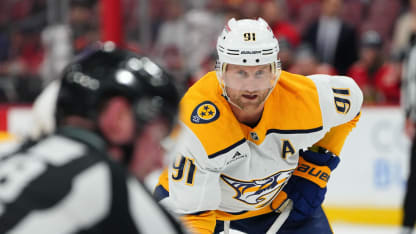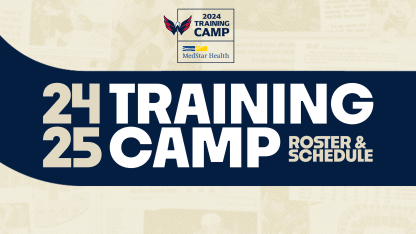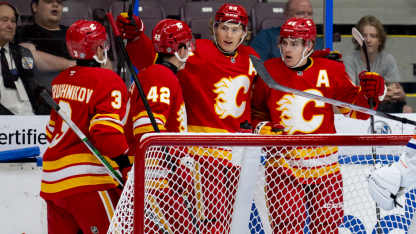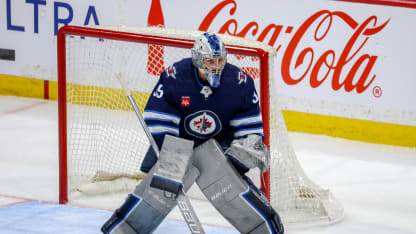TALKING POINTS: Bowman discusses Holloway & Broberg offer sheets
TALKING POINTS: Bowman discusses Holloway & Broberg offer sheets
On Tuesday, Edmonton’s General Manager and Executive Vice President of Hockey Operations spoke to the media about the team’s decision to not match the offer the Blues made to the forward and defenceman.
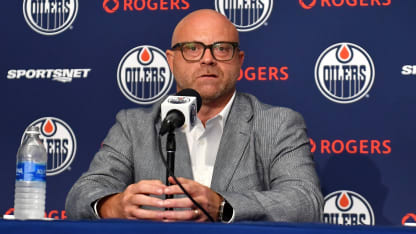
EDMONTON, AB – Oilers General Manager & Executive Vice President of Hockey Operations Stan Bowman held a virtual media availability on Tuesday to discuss the team’s decision to not match the offer sheets presented by the St. Louis Blues to restricted free agent forward Dylan Holloway and defenceman Philip Broberg.
Bowman’s opening comments:
Hello everyone, thank you for taking the time to be here. I understand there are many questions and I’m eager to address them. Let’s start by discussing our recent activities since we received the offer sheets last week. I’ll provide some insight into the thought process behind our decision. Afterward, I’ll be glad to entertain any questions you might have. When the offer sheets arrived last week, our team worked diligently to assess our current position and evaluate all possible options. We kept an open mind, not dismissing any possibilities immediately. Eventually, we identified four potential courses of action.
We spent several days exploring four different scenarios. The first scenario involved matching both offer sheets; the second involved matching Broberg and not matching Holloway; the third was the reverse, matching Holloway, not Broberg; and the fourth was not matching either offer. We carefully considered the immediate, short-term, and long-term effects of each scenario on our team for this year, the trade deadline, and the off-season. Our goal was to envision how our team would look under each scenario and play that out. Ultimately, we chose the scenario that made the most sense given our current situation.
I believe the staff did an excellent job. We spent a significant time analyzing and evaluating various options. During this process, we identified several areas that required further investigation. Over the past week, I had numerous phone calls with the majority of league teams to understand their roster plans, whether they intended to remove or add any players. We explored every possible opportunity, but ultimately, we decided not to match either offer sheet.
To put it simply, our decisions were based on opportunities and not on the players’ performance. I want to emphasize that our players were not a point of concern. This was a business decision regarding our short and long-term financial stability with the salary cap. As a result, we were able to conduct other transactions. Once we decided not to match the offer sheets, we knew we would gain some assets, which led to further discussions. Our goal was to gain flexibility and options for the future, and we believe we achieved this through our decisions.
We were not confining ourselves to one specific route for this season. Therefore, we undertook subsequent steps to incorporate some young players, along with extra draft picks and prospects. In examining the entirety of the situation, we were up against a tough scenario, but I believe we advanced with the most beneficial transactions that have positioned us favorably for training camp.
Stan addresses the media regarding the offer sheets from Holloway and Broberg.
On having an older team with some veteran free agent additions:
There are multiple perspectives to consider. Undeniably, the Oilers have become a desirable team for players prioritizing a championship over other factors. Every player is unique and at varying stages in their career, but it’s clear that those who opt for Edmonton, possibly even sacrificing higher pay, see potential in our team and aspire to contribute to it. This is a positive aspect and it’s our hope it persists as an objective for our team. The key to turning this into a consistent reality is maintaining a competitive team that attracts players from across the league who are focused on winning and view our team as the place to achieve that.
It wouldn’t be accurate to say we’re exclusively focusing on older players. While there’s an undeniable advantage in having older players due to their extensive experience and diverse situational knowledge, we’ve also incorporated a few younger players into our organization. These young players, such as Podkolzin and Ty Emberson, already have some NHL experience and are striving to cement their places as regular NHLers.
This isn’t a black-and-white situation. Including young players in the team can certainly be beneficial, as they bring a fresh dynamic, often filled with energy and excitement. These players are typically new to the NHL or have been away for several years. We’re certainly not against having younger players. In all likelihood, we’ll have a mix of both young and experienced players. The crucial factor for players like Podkolzkin and Emberson is their affordable salary cap hits. Considering our team’s current and future situation, maintaining salary cap space will be essential for us, as well as having flexibility. Generally, both young and veteran players have lower cap hits, while the contracts of intermediate players tend to be higher.
On the possibility of two younger players dictating the team’s salary cap position:
Returning to my initial remarks, we were assessing our circumstances when those offer sheets arrived. Considering this and our other limitations, we decided it wouldn’t be wise to restrict our future options. This decision isn’t about the players’ skills or talents, but rather about positioning ourselves optimally for future possibilities. As we are in August, every team will inevitably experience highs and lows throughout the season. It’s crucial to remain adaptable as player performance can be unpredictable. The alternative scenarios of matching either or both offers would have significantly impacted our salary cap, not just for this season but also for future ones. Therefore, we made the decision we did.
On losing two defencemen from last season in Broberg and Cody Ceci:
Indeed, we do have that. It is crucial for us to establish a robust defensive strategy before we reach the critical stretch run. At this stage, I believe we have numerous alternatives and players who we are hopeful will be able to step in and fulfill a role. It’s undeniable that our team’s composition is not the same as it was during Game 7 a few months back. Therefore, one of our objectives is to provide these new defencemen an opportunity to prove their worth.
Stecher is not entirely new, but he didn’t get much playtime last season. In addition, we also have Brown and Emberson, making it three players who need a chance to prove their worth. We are in a different situation compared to last year and are hopeful that these players can step up. This situation also potentially allows us to save some cap space, positioning us to possibly add new team members in the future if necessary.
On the start of contract extension negotiations with Leon Draisaitl:
I anticipated that question, which is not surprising considering the high level of interest in Leon. I can confirm that we have initiated discussions with Leon and his representative. However, I prefer not to divulge any further details. Over the years, I’ve found it’s most appropriate to keep these conversations private, in fairness to both Leon and his agent. This should not be interpreted negatively. I simply prefer not to impose any timelines on the matter. We have started the process and we’ll definitely keep everyone updated as things progress.
On the injury status of Evander Kane heading into the season:
I think it’s important to clear up a few things. There seems to be some confusion about the process of addressing injured players, the effects of long-term injuries on their cap hit, and replacement possibilities. I’ll attempt to provide a brief explanation here. When a player, like Evander in this case, is injured, the future course of action lies between him and the medical team. I don’t have any influence over it, and neither should I. My primary concern is to support Evander and ensure his health recovery.
There are several possibilities when an injury occurs. Treatment and rehabilitation are typically the first steps, eventually leading to the player’s recovery and return to the game. In some cases, immediate surgery is clearly the only option. However, there are instances where the best course of action isn’t so straightforward, and there are multiple possible paths to recovery for the player to consider. This decision is ultimately up to the player, and in this case, we fully support Evander’s choices. Presently, we’re dealing with this third scenario. Whether Evander will be absent for a short or, if surgery is necessary, a longer duration of the season, is yet to be determined. I don’t have any say in this, and it’s something that Evander will need to discuss and decide with his medical team.
I believe the relevance of this discussion stems from the misconception that if a player is injured and placed on long-term injury, there’s no need for trades or concern as it’s not a problem. However, this is not entirely accurate. It’s crucial to factor in that player’s impact on the salary cap. He could either be a part of your regular team capture once off LTI, or if his injury extends beyond 24 days and 10 games, he can be placed on long-term injury. But, it’s vital to have a plan to activate him once he recovers. This was a key point in our discussions – starting the season with a player on long-term injury might be manageable if he’s out for at least a month. However, planning for his return when he’s fit and ready to play posed a significant challenge.
Another point I’ll make is that with long-term injuries, no cap space is accumulated. Therefore, if you utilize the long-term injury for several months and then reactivate the player, you start with zero cap space and try to build it up. However, you won’t be able to accumulate much in just a month. These were all considerations in our decision-making process. As such, we’re currently positioned to begin the season with Evander Kane not having any injury status. He will be treated just like any other player. Should he be fit to play immediately, that would be excellent. If not, we won’t have any issue accommodating him once he’s fit.
On the additions of Vasily Podkolzin, Ty Emberson and Paul Fischer:
To provide some background, I can discuss all three players in question. One of our practices during situations like the one we faced last week is to consult our staff and explore any links they might have had with the mentioned players in my discussions with other teams. In Emberson’s case, I did converse with Kris (Knoblauch), who is quite familiar with Ty. His feedback about Ty’s game was highly positive. He cherished having him in his Hartford team, where Ty was a highly effective player. I believe it’s crucial to have a comfort level between the coach and a player being brought in, though it’s not usually the case, especially when they’ve been coached elsewhere. However, in this instance, it was beneficial.
Podkolzin was a high draft pick, 10th overall, which speaks to his pedigree. He demonstrated his potential with a strong rookie year in the NHL. However, his career has not followed the same trajectory since then, with most of his time spent in the American League. This may be due to regime changes and other circumstances that can affect a player’s performance. It’s not necessarily a reflection on him or anyone else, as we’ve seen other players struggle in similar situations.
What stands out about Podkolzin is his skill set. He has the ability to score and possesses a powerful shot. He is a strong, physical player who excels in a straight-line, north-south type of game. His readiness to engage in the game is something I particularly appreciate. He can dominate in the offensive zone, and when he doesn’t have the puck, he’s not afraid to use his strength and power. This combination of skills is impressive and gives us hope that we can help him regain the form he showed in his draft year and his first professional year. It’s now up to our coaching team to help him reach his potential. A fresh start can often be beneficial for players like Podkolzin.
I’ve known Paul Fischer for a long time, as he grew up here in Chicago. I’ve watched him since he was a child, playing countless games throughout the years. He eventually joined the U.S. national team and was progressing excellently. Despite an injury during his draft year, which likely impacted his draft position, his talent is undeniable. I observed him last year at Notre Dame, where he stood out as a freshman defenceman playing a significant role on the team. He’s also potentially on the U.S. World Junior team. His skills, size, and likability make him a great player. He’s young and has room for improvement. Beyond his skills on the ice, I’ve come to know him as a person. He’s a determined young man, eager to improve. We’re working on building our team and investing a lot of time in player development. Our goal is not only to identify promising young prospects, but to also enhance their growth and development so they can reach the NHL sooner.
On Bowman’s initial reaction to receiving two offer sheets from the same team:
Undeniably, it was a challenging situation. It’s rare to deal with offer sheets, let alone two simultaneously. My immediate response was to buckle down and get to work. Once the offer sheets are in, I can see why fans and media might focus on other aspects, but I wasn’t distracted by that. My focus was on the future. We now have a decision to make. We’re faced with a complex problem that we need to solve. It was definitely difficult to determine the best course of action. However, looking at the entire situation, I’m confident in our ability to navigate it in the most advantageous way, giving us various options for the future.
On whether he harbours any negativity towards the Blues after the offer sheets:
I believe it’s essential to distinguish between business and personal matters. My acquaintance with Doug Armstrong has spanned quite a few years. We’ve had numerous confrontations during my time in Chicago while he remained in St. Louis. However, I don’t perceive it that way. I realize that every manager might have to face this scenario, and it’s now our duty to respond appropriately and do what’s most beneficial for us. It’s crucial not to let personal emotions interfere with such matters. We must maintain a professional relationship with all league managers, which I plan to continue doing.
On the possibility of targeting any more players between now and the start of the season:
At this stage, nothing is ruled out. I believe it’s not beneficial to shut any possibilities now. Perhaps I should’ve made it clear earlier that we have some new team members that we need to provide an opportunity. They joined us for a reason. In Emberson’s case, we’ve just acquired him through a trade. So, we should give them a chance to prove their worth and contribute to our team. Part of my role is to explore the options we have, be it through additional trades or free-agents currently available. I plan to do so, though I can’t assure if it would yield any results. Our constraints remain the same, and our salary cap situation remains unchanged. We’ve been cautious to maintain some flexibility for the future. But, in short, yes, we are indeed open to discussions with players if we find someone who seems suitable to join us.

